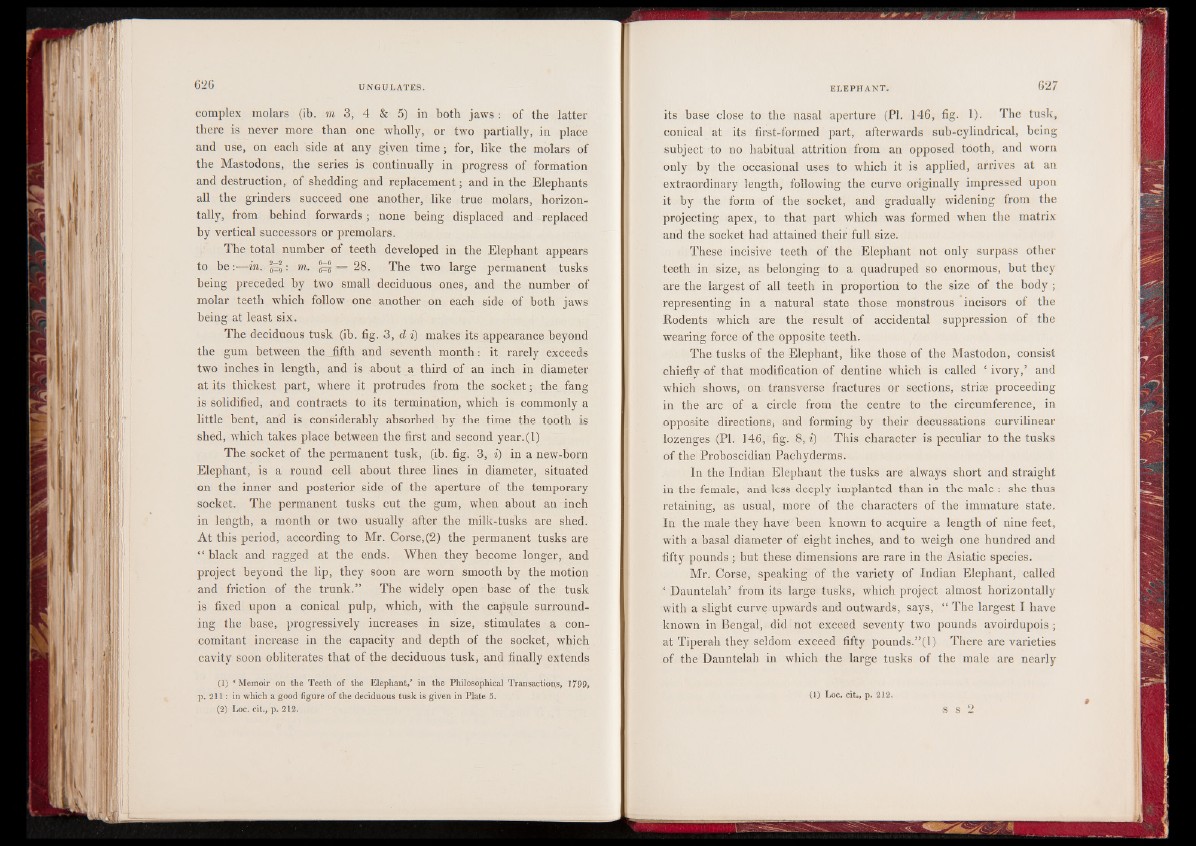
complex molars (ib. m 3, 4 & 5) in both jaws: of the latter
there is never more than one wholly, or two partially, in place
and use, on each side at any given time; for, like the molars of
the Mastodons, the series is continually in progress of formation
and destruction, of shedding and replacement; and in the Elephants
all the grinders succeed one another, like true molars, horizontally,
from behind forwards; none being displaced and replaced
by vertical successors or premolars.
The total number of teeth developed in the Elephant appears
to be:—in. : m. ^ = 28. The two large permanent tusks
being preceded by two small deciduous ones, and the number of
molar teeth which follow one another on each side of both jaws
being at least six.
The deciduous tusk (ib. fig. 3, d i) makes its appearance beyond
the gum between the Jifth and seventh month: it rarely exceeds,
two inches in length, and is about a third of an inch in diameter
at its thickest part, where it protrudes from the socket; the fang
is solidified, and contracts to its termination, which is commonly a
little bent, and is considerably absorbed by the time the tooth is
shed, which takes place between the first and second year.(l)
The socket of the permanent tusk, (ib. fig. 3, i) in a new-born
Elephant, is a round cell about three lines in diameter, situated
on the inner and posterior side of the aperture of the temporary
socket. The permanent tusks cut the gum, when about an inch
in length, a month or two usually after the milk-tusks are shed.
At this period, according to Mr. Corse,(2) the permanent tusks are
“ black and ragged at the ends. When they become longer, and
project beyond the lip, they soon are worn smooth by the motion
and friction of the trunk.” The widely open base of the tusk
is fixed upon a conical pulp, which, with the capsule surrounding
the base, progressively increases in size, stimulates a concomitant
increase in the capacity and depth of the socket, which
cavity soon obliterates that of the deciduous tusk, and finally extends
(1) ‘ Memoir on the Teeth of the Elephant/ in the Philosophical Transactions, 1799,
p. 211: in which a good figure of the deciduous tusk is given in Plate 5.
(2) Loc. cit., p. 212.
its base close to the nasal aperture (PI. 146, fig. 1). The tusk,
conical at its first-formed part, afterwards sub-cylindrical, being
subject to no habitual attrition from an opposed tooth, and worn
only by the occasional uses to which it is applied, arrives at an
extraordinary length, following the curve originally impressed upon
it by the form of the socket, and gradually widening from the
projecting apex, to that part which was formed when the matrix
and the socket had attained their full size.
These incisive teeth of the Elephant not only surpass other
teeth in size, as belonging to a quadruped so enormous, but they
are the largest of all teeth in proportion to the size of the body ;
representing in a natural state those monstrous incisors of the
Rodents which are the result of accidental suppression of the
wearing force of the opposite teeth.
The tusks of the Elephant, like those of the Mastodon, consist
chiefly of that modification of dentine which is called ‘ ivory,’ and
which shows, on transverse fractures or sections, striae proceeding
in the arc of a circle from the centre to the circumference, in
opposite directions, and forming by their decussations curvilinear
lozenges (PI. 146, fig. 8, i) This character is peculiar to the tusks
of the Proboscidian Pachyderms.
In the Indian Elephant the tusks are always short and straight
in the female, and less deeply implanted than in the male % she thus
retaining, as usual, more of the characters of the immature state.
In the male they have' been known to acquire a length of nine feet,
with a basal diameter of eight inches, and to weigh one hundred and
fifty pounds; but these dimensions are rare in the Asiatic species.
Mr. Corse, speaking of the variety of Indian Elephant, called
‘ Dauntelah’ from its large tusks, which project almost horizontally
with a slight curve upwards and outwards, says, “ The largest I have
known in Bengal, did not exceed seventy two pounds avoirdupois;
at Tiperah they seldom exceed fifty pounds.”(l) There are varieties
of the Dauntelah in which the large tusks of the male are nearly
(1) Loc. cit., p. 212.
s s 2